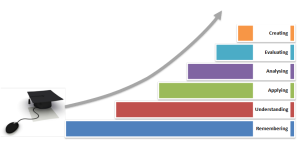From usability to re-usability: effective learning content design
—
Considering the time and effort spent by experts to create effective educational content, reusing content would be prudent for eLearning. Institutions could spend time on improving or localizing existing modules. Organisations spend (and spent!) millions of dollars in producing and managing knowledge among their individuals and groups. Although each investment if often covered by a dedicated budget allocation, there is usually a great benefit in reusing the output of such investment for further initiatives related to training, knowledge distribution, marketing.
IEEE defines reusability as: “the ability of a component to function and integrate outside the environment for which it was primarily designed.”
In order to maximise the reusability of your learning content, you should be able to structure it in single, independent, small-enough pieces of content. From a pedagogical and publishing perspective this is something we typically name “learning unit”, “unit of learning”, “learning object“, “content item” and such (eLearning gurus call those units of content “SCOs”, Shareable Content Objects, meaning that they should be self-contained and self-consistent units of content that can easily be shared across different courses).
This may have an impact on both pedagogy and technology.
From a pedagogical perspective, assuming that the scope of the e-learning module is primarily knowledge acquisition, a SCO should address a consistent set of learning objectives. The “design” phase of the learning content production process covers a relevant part of the overall investment. During this phase, it is important to start the conception of each learning unit having clear in mind which are the learning objectives that should be supported by each activity, at every level of granularity. This will help designing learning objects which are consistent and effective, having the marvelous ability to convey a measurable learning outcome. There are a variety of methodological patterns and tools that can be used to correctly define the learning objectives of a learning unit. Among them, “Bloom’s taxonomy” addresses the learning objectives definition through six cognitive domains (we suggest adopting the taxonomy revision done by Anderson & Krathwohl in 2001, which renames the six categories through the verbs Remembering, Understanding, Applying, Analysing, Evaluating, Creating).
Producing an effective eLearning offering means addressing extensively and consistently each of the above mentioned levels of human cognition, guiding trainees through the learning path that will help them to collect from their life experiences some examples of the new knowledge being acquired, and combine them to generate new patterns of knowledge (sorry, I am afraid we do not have enough time here to mention Lev Vygotsky‘s thoughts on creativity, but I promise there will be a dedicated blog entry soon!).
Thus, a correct definition of the learning objectives has a strong impact on learners (the target users of our learning units). A learner consuming a Learning Object should be able to achieve the declared learning outcomes by consuming the content item itself. This does not necessarily mean that additional external resources or referenced materials should not be used within the scope of a Learning Object (in SCORM terms, a SCO). Instructional Designers are always encouraged to provide drill-down materials to reinforce the learning process. But whatever material not strictly included (“embedded”) in a SCO should not be a mandatory component of the Learning Object, meaning that learners should be able to achieve the declared learning outcomes even in case they cannot access (“reach”) the additional material (“resource”, or “asset”).
Now, using terms such as “embedded” or “reachable” we immediately fall within the realm of technology. Indeed, from a technological perspective a self-consistent SCO is meant to be accessible in its entirety under the conditions in which the SCO itself is meant to be consumed (an intranet, a Learning Management System, the whole Internet).
A strict interpretation of this principle may be phrased as in the following:
…when designing a web-based learning unit, you should not reference external materials (e.g. through an absolute URL) unless you are sure that the URL will always be reachable.
This means for instance that no learning material will ever change or become unreliable, but also that relevant URLs will not require a specific authentication to be accessed, or will not be firewall-protected.
Nonetheless, a correct interpretation of this principle should take into account the actual context in which eLearning is being delivered. For instance, let us assume that I am commissioned a learning unit to be delivered to the employees of my company, and they are supposed to consume their eLearning path mainly (even solely) from within the company intranet. Am I supposed to include as mandatory learning resource a document that employees can reach at any time from within their intranet settings? Shall I decide to do so, will the fact that the URL will not be accessible on the internet (as well as by intranet users without the needed privileges) be an issue in the end?
To summarise (and, at some extent, to over-simplify), if we want to achieve an acceptable level of reusability for our learning content, we should have a clear, upfront definition of the target learning goals, and carefully define how our learning content strategy may help reaching them.
Those of you that are currently in the selection or adoption process for a learning content authoring and management tool should pay very much attention to its ability to support them in expressing and structuring the learning objectives first. All in all, the design of an effective learning offering starts from there.
